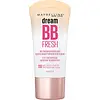What's inside
What's inside
 Key Ingredients
Key Ingredients

 Benefits
Benefits

 Concerns
Concerns

 Ingredients Side-by-side
Ingredients Side-by-side

Titanium Dioxide
Cosmetic ColorantWater
Skin ConditioningEthylhexyl Palmitate
EmollientGlycerin
HumectantOctyldodecanol
EmollientSilica
AbrasivePentylene Glycol
Skin ConditioningOctyldodecyl Xyloside
EmulsifyingPhenoxyethanol
PreservativeSodium Acrylate/Sodium Acryloyldimethyl Taurate Copolymer
Emulsion StabilisingHydrogenated Lecithin
EmulsifyingIsohexadecane
EmollientHydroxyethyl Acrylate/Sodium Acryloyldimethyl Taurate Copolymer
Emulsion StabilisingPEG-30 Dipolyhydroxystearate
EmulsifyingSodium Dehydroacetate
PreservativePentaerythrityl Tetra-Di-T-Butyl Hydroxyhydrocinnamate
AntioxidantCaprylyl Glycol
EmollientDisodium EDTA
Citric Acid
BufferingPolysorbate 80
EmulsifyingPotassium Sorbate
PreservativePropylene Glycol
HumectantChamomilla Recutita Flower Extract
MaskingAloe Barbadensis Leaf Extract
EmollientIron Oxides
Titanium Dioxide, Water, Ethylhexyl Palmitate, Glycerin, Octyldodecanol, Silica, Pentylene Glycol, Octyldodecyl Xyloside, Phenoxyethanol, Sodium Acrylate/Sodium Acryloyldimethyl Taurate Copolymer, Hydrogenated Lecithin, Isohexadecane, Hydroxyethyl Acrylate/Sodium Acryloyldimethyl Taurate Copolymer, PEG-30 Dipolyhydroxystearate, Sodium Dehydroacetate, Pentaerythrityl Tetra-Di-T-Butyl Hydroxyhydrocinnamate, Caprylyl Glycol, Disodium EDTA, Citric Acid, Polysorbate 80, Potassium Sorbate, Propylene Glycol, Chamomilla Recutita Flower Extract, Aloe Barbadensis Leaf Extract, Iron Oxides
Titanium Dioxide 5.8%
Cosmetic ColorantZinc Oxide 2.4%
Cosmetic ColorantCyclopentasiloxane
EmollientIsopropyl Myristate
EmollientPolyamide-5
Skin ConditioningDimethicone Crosspolymer
Emulsion StabilisingStearalkonium Hectorite
Gel FormingPolysilicone-11
Oryza Sativa Bran Extract
Skin ConditioningRosmarinus Officinalis Leaf Extract
AntimicrobialHelianthus Annuus Extract
EmollientTocopherol
AntioxidantMica
Cosmetic ColorantIron Oxides
Propylene Carbonate
SolventSynthetic Wax
AbrasiveHydrogen Dimethicone
Isopropyl Titanium Triisostearate
EmollientAluminum Hydroxide
EmollientSilica Silylate
EmollientOctyldodecyl Oleate
EmollientTitanium Dioxide 5.8%, Zinc Oxide 2.4%, Cyclopentasiloxane, Isopropyl Myristate, Polyamide-5, Dimethicone Crosspolymer, Stearalkonium Hectorite, Polysilicone-11, Oryza Sativa Bran Extract, Rosmarinus Officinalis Leaf Extract, Helianthus Annuus Extract, Tocopherol, Mica, Iron Oxides, Propylene Carbonate, Synthetic Wax, Hydrogen Dimethicone, Isopropyl Titanium Triisostearate, Aluminum Hydroxide, Silica Silylate, Octyldodecyl Oleate
 Reviews
Reviews

Ingredients Explained
These ingredients are found in both products.
Ingredients higher up in an ingredient list are typically present in a larger amount.
Titanium dioxide is a mineral UV filter widely used in sunscreens and cosmetics.
It is one of only two UV filters officially classified as “mineral” by regulatory agencies, the other being zinc oxide.
Titanium dioxide provides broad-spectrum protection mostly in the UVB and UVAII range, with some protection in the UVAI range.
While its UVA protection isn’t as strong as zinc oxide’s, the difference is minor.
A common myth is that mineral UV filters reflect UV light. However, modern research shows titanium dioxide absorbs UV radiation like chemical filters (~95% absorption & 5% reflection).
Thanks to its non-irritating nature, titanium dioxide is suitable for sensitive, acne-prone, or redness-prone skin. It is unlikely to cause "eye sting" like other sunscreen ingredients.
A major drawback of this ingredient is its white cast and thick texture. This is why mineral sunscreens often leave a white cast and are less cosmetically elegant than chemical/hybrid sunscreens.
To improve white cast and spreadability, micronized or nano-sized titanium dioxide is often used.
There are ongoing concerns surrounding nano-titanium oxide's impact on marine ecosystems.
There is no conclusive evidence that any form of titanium oxide (or any other sunscreen ingredients) will cause harm to marine ecosystems or coral reefs. The science is still developing but many consumers are keeping a close eye on this issue.
Please note, many destinations have reef-safety sunscreen rules. For instance, the U.S. Virgin Islands advises all visitors to use non-nano mineral sunscreens.
Nano mineral sunscreens once raised safety concerns about absorption into skin.
Extensive research has shown that they do not penetrate healthy or damaged skin; they remain safely on the surface and the top layer of dead skin (stratum corneum).
You'll likely find titanium dioxide bundled with alumina, silica, or dimethicone. These ingredients help make titanium dioxide highly photostable; this prevents it from interacting with other formula components under UV light.
Learn more about Titanium DioxideThis ingredient is a combination of red, black, and yellow iron oxide pigments. This combination of colors is usually found in foundation, because it results in a "skin" color.